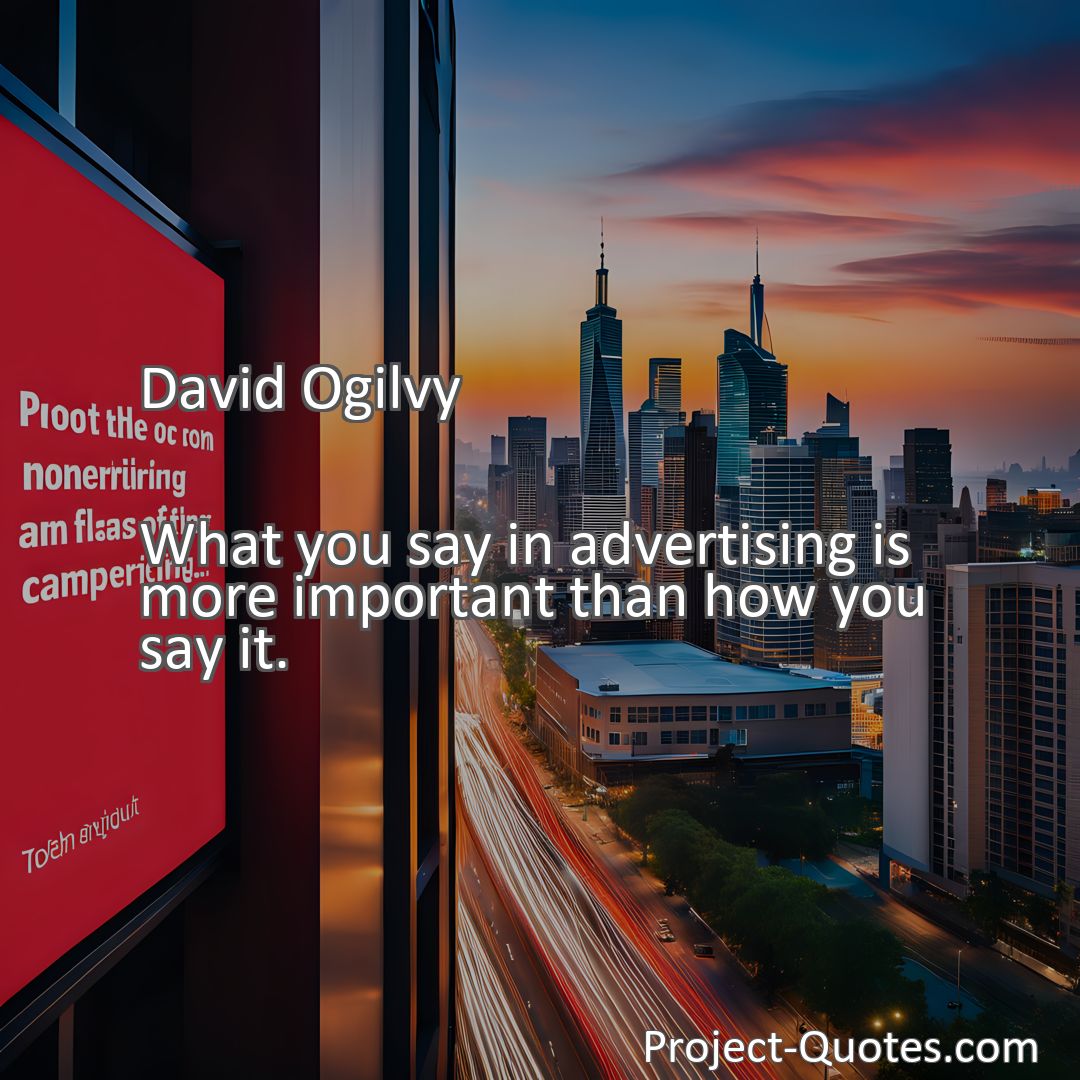What you say in advertising is more important than how you say it.
David Ogilvy
In today’s fast-paced world of advertising, flashy visuals and catchy slogans may capture initial attention, but they alone cannot sustain consumer engagement. The content of the message, highlighting a product’s unique features and benefits, plays a crucial role in convincing potential buyers. Balancing persuasive content with a captivating delivery is key to standing out in the competitive advertising landscape.
Table of Contents
Meaning of Quote – What you say in advertising is more important than how you say it.
When it comes to advertising, one might think that the way a message is delivered is key to capturing an audience’s attention. However, according to the renowned advertising executive David Ogilvy, the content of the message itself holds far more significance. Ogilvy’s belief that “What you say in advertising is more important than how you say it” emphasizes the importance of substance and relevance in effectively conveying a message to potential consumers.
In today’s fast-paced and media-saturated world, advertisers face fierce competition for consumers’ attention. With countless messages bombarding individuals from all directions, it is crucial to cut through the noise and stand out. While catchy slogans, jingles, and eye-catching visuals play a role in capturing initial interest, they alone cannot sustain consumer engagement. Instead, it is the substance of the message that determines whether it resonates with the target audience.
To better understand Ogilvy’s perspective, let’s consider an example. Imagine a company selling a new energy drink. If their advertising solely focuses on flashy visuals and a catchy song without providing any information about the product’s benefits, potential consumers may find it difficult to understand why they should choose this drink over others. On the other hand, if the advertisement clearly communicates how the drink boosts energy levels, improves focus, and enhances performance, consumers are more likely to be convinced of its value and consider making a purchase.
In essence, the ability to communicate a product’s unique features, benefits, and value propositions is critical in advertising. When crafting an advertisement, it is essential to remember that consumers are seeking solutions to their needs, desires, or problems. By shifting the focus from how the message is delivered to its core content, advertisers can effectively address those concerns and connect with their target audience.
However, the significance of content does not imply that how a message is conveyed holds no importance. Ogilvy’s quote should not be interpreted as advocating for drab, uninteresting advertising. On the contrary, Ogilvy was a master of combining persuasive content with captivating creativity. He understood that an advertisement’s presentation, aesthetic appeal, and tonality work hand in hand with the message itself, enhancing its impact and reach.
An advertisement’s delivery encompasses various elements, including language, tone, visual design, and brand identity. Each of these components plays a role in creating a cohesive and persuasive message. For example, a fun and vibrant tone might be more suitable for an advertisement targeting young consumers, while a more sophisticated and professional tone might resonate with an older audience. The key is to select the appropriate style and tone that aligns with the target audience’s preferences, values, and interests, while still conveying the essential information effectively.
Moreover, the presentation of an advertisement can significantly affect how the message is perceived. Attention-grabbing visuals, such as striking images, vibrant colors, and unique layouts, can help capture viewers’ interest and make the advertisement memorable. Additionally, using storytelling techniques, humor, or emotional appeals can create an emotional connection with the audience, enhancing engagement and brand recall. By combining compelling content with an appealing delivery, advertisers can maximize the effectiveness of their campaigns.
Ultimately, what Ogilvy highlights through his quote is the importance of striking a balance between what is said and how it is said in advertising. While the content of the message provides the substance and relevance, the delivery of the message ensures it captures attention, engages consumers, and leaves a lasting impression. By prioritizing both aspects, advertisers can create impactful and persuasive advertising campaigns that drive consumer action.
In conclusion, David Ogilvy’s quote, “What you say in advertising is more important than how you say it,” emphasizes the significance of substance and relevance in advertising messages. While catchy slogans, jingles, and visual aesthetics can capture initial attention, it is the content of the message that persuades consumers to take action. Balancing persuasive content with a captivating delivery is crucial for advertisers striving to stand out in today’s competitive landscape. By understanding Ogilvy’s message, advertisers can create compelling and effective campaigns that resonate with their target audience, ultimately leading to increased brand recognition, customer engagement, and business success.
I hope this quote inspired image brings you hope and peace. Share it with someone who needs it today!


